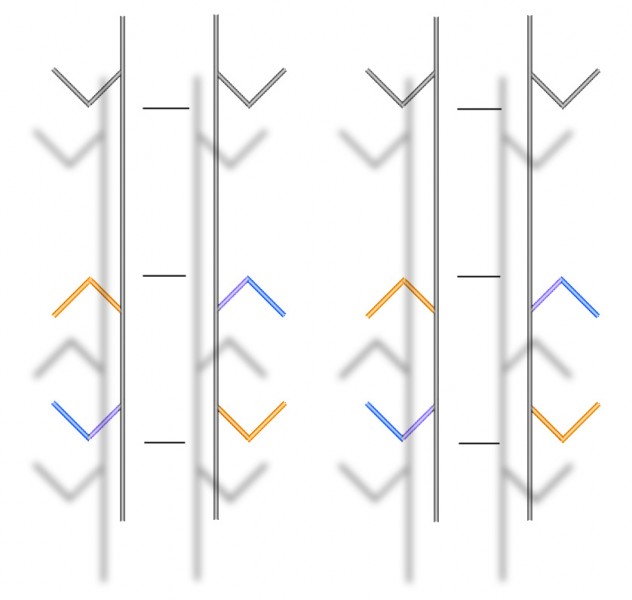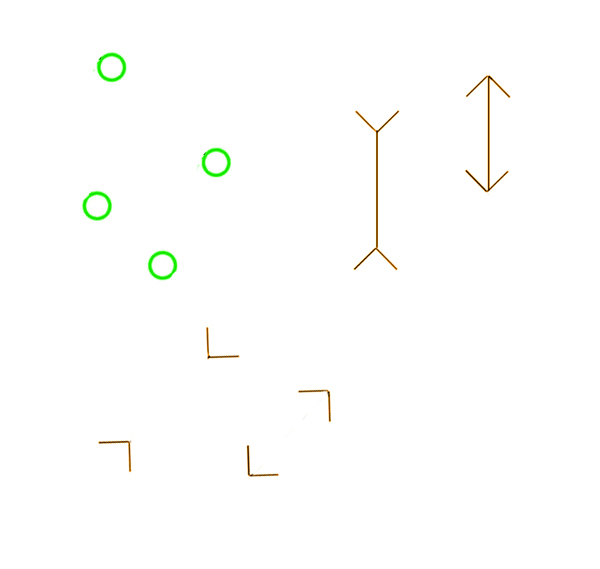This is a stereo picture-pair, but you can see what’s happening here without having to view the images in 3D if you prefer. However, if you’ve not got the knack, and would like to practice on this post, here’s how. Hold up a pen about in the middle, between the two pictures, and about five inches from your eyes (careful!). If you now try to focus on the tip of the pen, you’ll notice that the blurry image of the figure has doubled. Now move the pen-tip away from your eyes, and notice that the two blurry middle images of the figure are beginning to overlap. Once they overlap (probably when the pen-tip is something like ten inches away from your face), see if you can get them to overlap exactly, and then come into focus. If that doesn’t work, try this great tutorial on another site. Or try our earlier post about stereo picture pairs.
If you’ve got it, you should see the parallel vertical bars and their attachments floating in front of a surface with their shadows thrown on it. You’ll see the same if you view the image normally, but not with the illusion of 3D. So what’s going on?
It’s a much stronger version of some paradoxical effects I showed in an earlier post. The tips of the arrowheads are all objectively exactly the same distance apart, as indicated by the horizontal lines aligned with them in between the vertical bars. But that’s not how they appear if you look at the arrowheads: the inward pointing arrows look much further apart than the outward pointing ones. (That’s the Mueller-Lyer illusion). But now check out the lower, coloured arrowheads. The coloured arms that contact the vertical bars are objectively aligned, but appear not to be – the upper arm in each case seems shifted a bit upward, and the lower arm a bit downward. (That’s the Poggendorff illusion). For the arms to appear out of alignment like that, you’d imagine the arrowheads must move further apart. But that’s exactly the opposite of what the Mueller-Lyer illusion is making them seem to do.
The Mueller-Lyer and Poggendorff illusions are really puzzling, after over a century of study, even when considered one by one, let alone when in competition with one another, as here. There isn’t even agreement about whether they arise because of two-dimensional properties of the figures, or because of processes involved when we interpret them as arrays of lines in space. If you fancy more on the Poggendorff illusion, there’s an earlier post you could start with. For the Mueller-Lyer, try this figure.
Supporters of an explanation depending on depth processing (notably the Bristol perceptual scientist Richard Gregory) point out that if you look at the upper right hand version of the illusion here, the inward pointing arrows look like a receding corner, one that you’re looking into, whereas the outward pointing arrows suggest a corner jutting out towards you. That could make the receding, and so more distant corner look larger, thanks to the size-constancy effect. But I’m not so sure. First there’s the 3D version at the start of the post, in which the illusion arises in a figure in which the arrowheads themselves look as flat as pancakes. Well, it can be argued that what matter are depth cues that we pick up without being conscious of them, very early on in visual processing. OK, that could be how it is with the arrowheads. But then the illusion looks even stronger to me in the lower left version here, where the perspective character of the arrowheads is reduced. And then there’s the version with circles, upper left, which doesn’t seem to allow for any depth interpretation at all.
But the brain is fiendishly subtle. The jury is still out on this.


